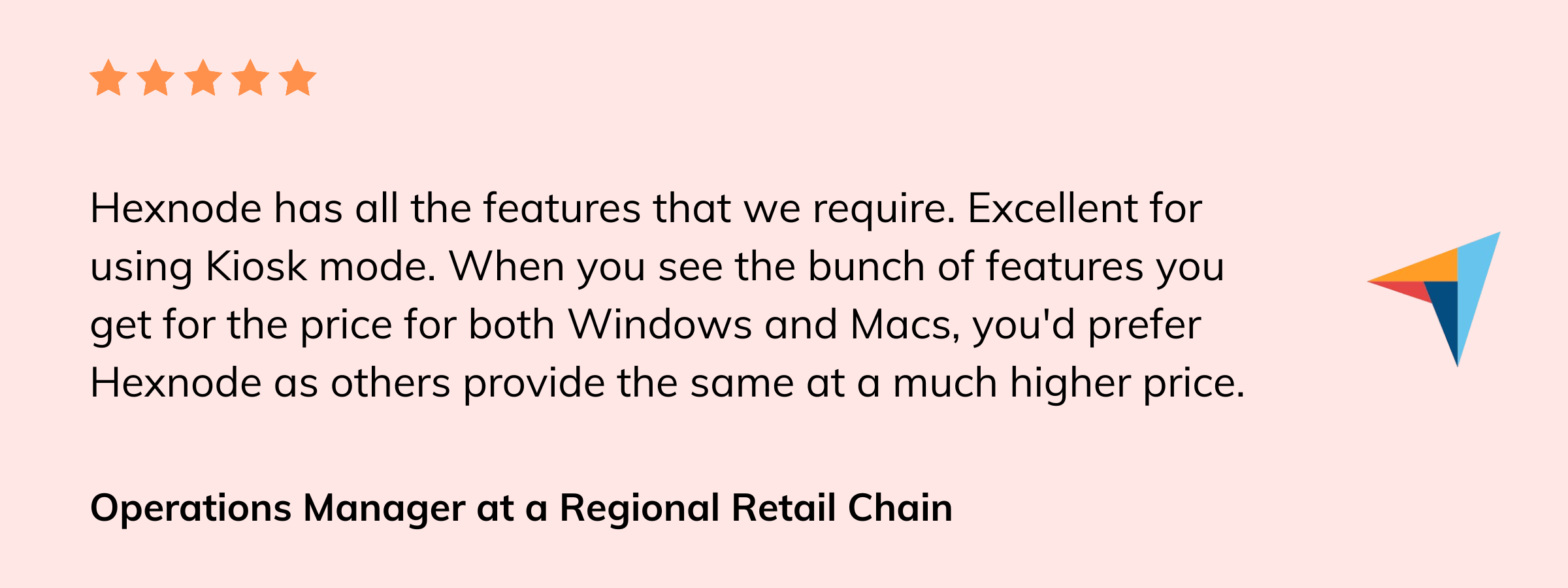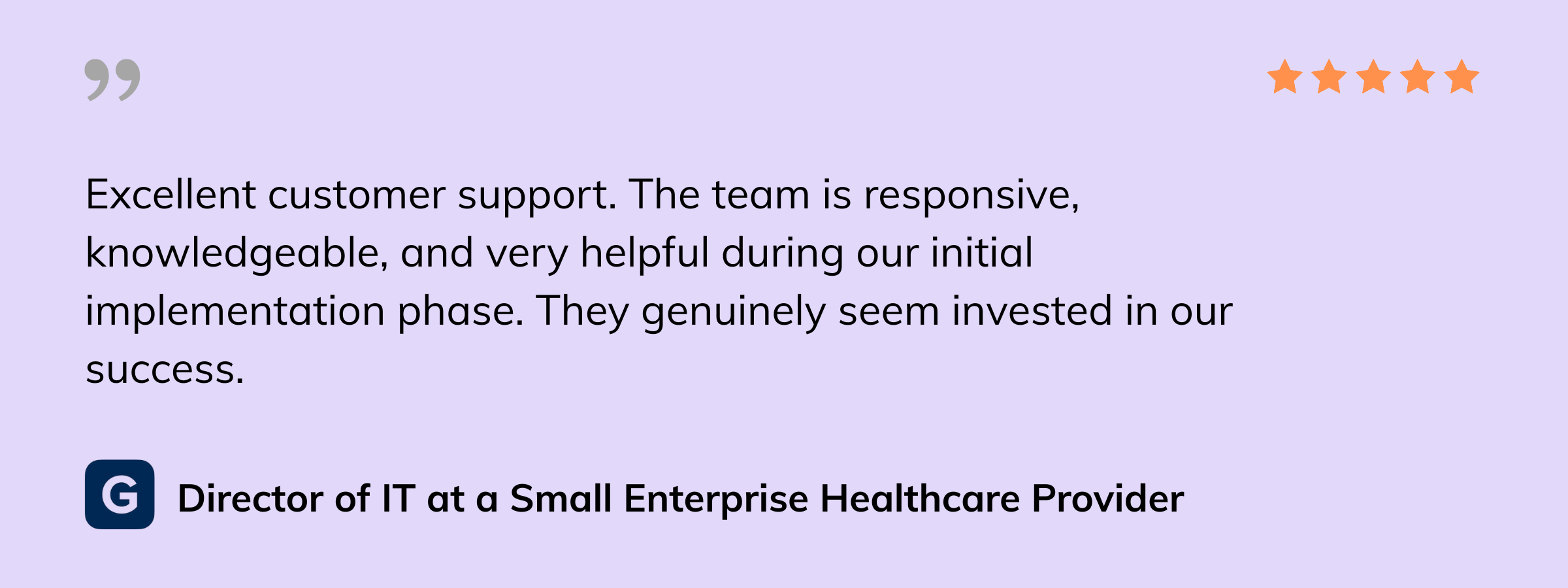A guide on how to reduce IT costs using UEM
This guide helps you move beyond features by providing a clear framework for calculating the ROI of a UEM solution.

Get fresh insights, pro tips, and thought starters–only the best of posts for you.
Evan Cole
Nov 15, 2025
26 min read

In today’s complex enterprise environment, the IT manager’s daily challenge isn’t just managing endpoints – it’s securely managing a chaotic mix of corporate laptops, BYOD smartphones, rugged field scanners, and specialized kiosk displays.
This comprehensive report dives into two leading contenders in the UEM space: Hexnode UEM and Citrix Endpoint Management (CEM). While both platforms offer robust MDM and MAM capabilities, their foundational philosophies – Hexnode’s focus on platform agnosticism and deep device control versus CEM’s strength in application containerization and Digital Workspace integration.
Our purpose is to provide a detailed, side-by-side technical analysis across compatibility, security, enrollment, and TCO, equipping the IT decision-maker, with the objective data required to select the platform best aligned with your unique operational and security requirements.
Selecting the right Unified Endpoint Management (UEM) solution is a strategic decision that impacts security, user experience, and operational efficiency. This executive overview compares Hexnode and Citrix Endpoint Management (CEM) based on their foundational UEM philosophies to provide IT decision-makers with a clear, high-level comparison.
This head-to-head comparison examines the fundamental identities of the two vendors, which heavily influence their product development and feature emphasis.

The breadth of supported operating systems and device types is a critical factor for IT managers facing increasingly diverse endpoint environments (COPE, BYOD, and specialized devices). This section provides a direct comparison of Hexnode and Citrix Endpoint Management (CEM) in terms of platform coverage and specialized device capabilities.
Hexnode’s core strength lies in its broad, platform-agnostic support designed to centralize management across traditional and niche enterprise devices.
iOS/iPadOS & macOS: Comprehensive support for MDM capabilities, including Apple Business/School Manager (ABM/ASM) integration, VPP app deployment, and configuration for all standard policies (passcodes, network, restrictions).
Android: Robust support for Android Enterprise (Device Owner, Profile Owner), and includes integrations with major OEM programs like Samsung Knox, LG GATE, and Kyocera.
Windows: Supports Windows 10/11 devices, including silent app installation via MSI and management features like BitLocker enforcement, Firewall configuration, and Custom Script execution (PowerShell, BAT).
Linux: Offers strong support for popular desktop distributions including Ubuntu, Fedora, and Debian, with capabilities for policy enforcement, app inventory, and remote command execution (using Bash, Python, Perl, etc.).
ChromeOS: Full support for Chrome device policies and enrollment.
Rugged & IoT: Hexnode actively supports industrial-grade devices from vendors like Zebra, Honeywell, and Datalogic. This includes specialized features essential for logistics and manufacturing, such as extensive Kiosk Lockdown modes (single/multi-app, web kiosk) for Android, iOS, and Windows.
Connected Devices: Includes native support for tvOS (Apple TV), Android TV OS, Fire OS, and recently introduced support for visionOS, demonstrating a commitment to managing a wide range of dedicated-use devices.
CEM focuses its platform support around devices that access the Citrix Digital Workspace, prioritizing secure app delivery and the desktop experience.
iOS/iPadOS & macOS: Provides comprehensive MDM and strong Mobile Application Management (MAM) via MDX technology. Supports ABM/ASM for bulk deployment.
Android: Full support for Android Enterprise (Device Owner and Profile Owner). It integrates with Samsung Knox for enhanced security.
Windows: Primarily focuses on modern OS versions, supporting Windows 10 and Windows 11. Key capabilities include automatic enrollment through the Citrix Workspace app and a full suite of MDM policies (BitLocker, Firewall, App Lock).
Chrome OS: Supports enrollment and basic policy configuration, primarily centered around enabling access to the Citrix Workspace.

This guide provides a strategic, step-by-step plan to ensure a successful, risk-free migration to a new UEM solution.
Download White paperVirtualization/DaaS: CEM’s most unique advantage is its deep, native integration with Citrix Virtual Apps and Desktops (CVAD), allowing for context-aware security policies that span the physical endpoint to the virtual session.
VR/AR (Implied): While not explicitly listed as a core supported OS in a dedicated feature matrix, Citrix’s documentation discusses the role of its technology in supporting advanced user experiences in healthcare, including VR/AR, primarily through its optimization for virtual applications running on these endpoints rather than through specific native device management policies like Hexnode’s visionOS support.
IoT: Support for non-traditional endpoints is primarily focused on Alexa for Business integration, linking voice assistants into the digital workspace ecosystem.
In summary, for IT teams managing a highly diverse set of endpoints, including specialized devices, rugged hardware, or desktop Linux, Hexnode offers a superior breadth of native platform support and granular control. Conversely, for organizations deeply invested in the Citrix Digital Workspace or those prioritizing application-level security and seamless access to virtualized resources, Citrix Endpoint Management’s tight integration provides a more cohesive management experience, even if its OS breadth is slightly narrower on the non-traditional spectrum.
Effective device enrollment and comprehensive policy enforcement are the operational backbone of any UEM solution. This section details how Hexnode and Citrix Endpoint Management (CEM) handle device onboarding (zero-touch, BYOD) and compare their core management features, including application deployment and remote support tools.
Both platforms support modern, zero-touch enrollment methods, but their focus differs slightly in scope and required integration points.
Zero-Touch/Corporate Enrollment: Offers robust, comprehensive zero-touch support across all major platforms:
Apple ADE (DEP): Automated Device Enrollment via Apple Business/School Manager.
Android ZTE: Seamless provisioning for Android Enterprise (Device Owner or Work Profile on COPE).
Windows Autopilot: Pre-configured Windows device setup.
Samsung KME: Persistent enrollment via Knox Mobile Enrollment.
ROM-based Enrollment: Specialized, deeper enrollment for dedicated-use Android devices during manufacturing or flashing.
BYOD & Manual: Supports user-centric enrollment via multiple methods:
Self-Enrollment: Using credentials from integrated directories (AD, Entra ID, Google Workspace, Okta).
Token/QR Code/Email/SMS: Simple user-guided enrollment for personal devices (BYOD) to set up a managed Work Profile/Work Space.
Bulk: CSV file uploads for serial number/IMEI-based enrollment for large-scale device provisioning.

Zero-Touch/Corporate Enrollment: Provides standard zero-touch capabilities primarily focused on large-scale enterprise deployments:
Apple Deployment Programs: Supports bulk enrollment through ABM/ASM.
Android Enterprise Provisioning: Supports EMM token, NFC, QR code, and Zero-touch enrollment for various Android Enterprise modes.
Windows: Automatic enrollment of Windows 10/11 devices can be achieved through the Citrix Workspace App.
BYOD & Manual: Focuses heavily on application-level security for BYOD:
Secure Hub: Users enroll via the Citrix Secure Hub app, which enforces policies and provides access to the managed app store.
Work Profile: Supports the creation of a separate, managed Work Profile for BYOD Android devices.
Authentication: Strong integration with Citrix Gateway and various identity providers (Azure AD, Okta, certificate-based authentication) to control enrollment and resource access.
The primary difference here is Hexnode’s focus on deep device-level control versus CEM’s emphasis on application security and virtual resource access.
Security is the most critical function of any UEM solution. The security postures of Hexnode and Citrix Endpoint Management (CEM) are fundamentally different, reflecting their core philosophies: Hexnode focuses on device and OS-level compliance, while CEM emphasizes application and data containerization within the Digital Workspace.
This comparison focuses on the core features used to segregate and protect corporate data from unauthorized access or leakage.
Encryption: Enforces mandatory device-level encryption policies, including native support for BitLocker (Windows) and FileVault (macOS). Communication between the device and the server utilizes secure TLS/HTTPS protocols.
Containerization: Supports OS-native containerization (e.g., Android Enterprise Work Profile, iOS Managed Apps). IT can enforce “open-in” policies, restrict copy/paste functionality between managed and unmanaged apps, and control screen capture.
Access Control: Enforces strict password and passcode policies, and uses Certificate-Based Authentication for secure Wi-Fi and VPN access.
Conditional Access (CA): Hexnode extends CA primarily through device compliance status (e.g., checking for encryption, OS version, jailbreak status). It integrates with Microsoft Entra ID to enforce access to cloud apps like Office 365 only for Hexnode-managed, compliant devices.
Encryption: Supports device-level encryption policies and provides AES-based encryption for managed content within its proprietary secure container.
Containerization: CEM’s strongest feature is its proprietary Mobile Application Management (MAM) layer, often referred to as MDX technology. This securely wraps corporate apps, creating a micro-VPN tunnel for data access and preventing data leakage (e.g., export to unmanaged storage, print/email restrictions). This is crucial for BYOD programs.
Access Control: Highly context-aware security based on user, location, and device status. CEM uses the Citrix Gateway to enforce context-based conditional access to virtual apps, desktops, and managed mobile apps.
Micro-VPN: Provides per-app VPN functionality for managed apps, ensuring secure, encrypted transmission directly to the corporate network without requiring a full device-level VPN.
Effective security requires real-time monitoring and the ability to respond instantly to threats.
Threat Detection: Includes features like Jailbreak/Root detection on mobile devices and continuous OS version compliance checks. Policies can be configured to automatically restrict access or wipe the device upon compliance violation.
Remote Actions: Offers comprehensive, multi-platform remote actions:
Selective Wipe (Corporate Wipe): Removes corporate-only data (apps, configurations, profiles) from BYOD devices.
Full Wipe (Factory Reset): Wipes all data and restores corporate-owned devices to factory settings. Supported across all platforms, including Windows, macOS, Linux, and specialized OS.
Lost Mode/Lock: Locks the device, displays a custom message, and tracks location.
Industry Compliance: Hexnode is SOC 2 Type 2 Attested (No Exceptions), ISO/IEC 27001:2022 Certified, and offers specific tools and policy templates to help organizations align with regulations like HIPAA, GDPR, and PCI DSS. Its compliance engine automatically alerts and remediates devices that fall out of specified policy adherence.
Threat Detection: Primarily utilizes its Analytics component to assess user behavior and device posture risk. It monitors device properties (e.g., Jailbreak/Root status) and network context to dynamically enforce policy decisions.
Remote Actions: Supports essential remote actions for data security:
Selective Wipe: Removes managed apps and data container contents.
Full Wipe/Lock: Standard device lock and factory reset.
Industry Compliance: Citrix, as a larger platform, offers strong commitment to industry standards. Its cloud-based services are generally SOC 2 and ISO 27001 compliant. For verticals, Citrix offers Business Associate Agreements (BAAs) and documented configurations to assist customers in achieving HIPAA compliance. It provides strong controls that align with GDPR requirements, especially through its robust data segregation and control over PHI/PII.
The value of a UEM solution is often amplified by its ability to integrate seamlessly with the existing enterprise IT ecosystem. This includes Identity Providers (IdPs), IT Service Management (ITSM) tools, and the flexibility offered through open APIs.
Integration with Identity Providers is essential for Single Sign-On (SSO), conditional access, and simplifying user provisioning.
Core Directory Services: Hexnode provides robust, native integrations for directory and group synchronization:
Microsoft Entra ID (Azure AD): Supports user and group synchronization, Conditional Access (CA) integration to enforce device compliance, and enables enrollment using Entra ID credentials.
Microsoft Active Directory (AD): Supports integration via a lightweight AD agent for on-premises domain authentication, user/group syncing, and certificate deployment.
Cloud IdPs: Native support for key IdPs like Okta (including Okta Device Trust for conditional access) and Google Workspace for user authentication and enrollment.
Specialized Access: The Hexnode Access feature simplifies login to macOS and Windows devices using cloud IdP credentials, enabling network-style account management for local devices.
API Availability: Hexnode offers a comprehensive, RESTful JSON API with extensive documentation. This API allows developers to perform CRUD (Create, Read, Update, Delete) operations, enabling deep, custom integration with various enterprise software, reporting tools, and internal automation platforms.
Core Directory Services: CEM integrates tightly with the full suite of Citrix access products:
Azure AD: Supports integration through Citrix Cloud for administrator and subscriber authentication. It also supports Group-Based Administration and leveraging Azure AD for MAM enrollment via Citrix Gateway.
On-premises AD: Utilizes LDAP for direct authentication and user property lookups.
Citrix Gateway/ADC: The platform’s security gateway (NetScaler/Citrix ADC) is the central point for authentication, supporting LDAP, Certificate-Based Authentication, and multi-factor/nFactor authentication for both MDM and MAM.
Cloud IdPs: Supports authentication via Okta and other SAML 2.0 compliant IdPs, often routed through the Citrix Cloud or the Citrix Gateway for enhanced security controls.
API Availability: CEM provides APIs that are primarily used for managing virtual resources and automating tasks within the broader Citrix Workspace environment. Integration for core UEM tasks is often tightly coupled with the Citrix Cloud services.
Integration with ITSM and other key platforms is crucial for automating help desk workflows and asset management.
ITSM & Ticketing: CEM’s most significant ITSM integration is with ServiceNow:
Security & Workspace Tools: Deep native integration with other Citrix products:
The Total Cost of Ownership (TCO) for a UEM solution extends beyond the sticker price; it includes the licensing structure, feature segmentation across tiers, and potential external costs like specialized gateway infrastructure. Hexnode and Citrix Endpoint Management (CEM) employ distinctly different licensing philosophies that appeal to different market segments.
Hexnode follows a transparent, publicly listed, per-device licensing model, which is standard for dedicated UEM platforms.
Licensing Model: Per-Device/Per-Month subscription model, billed annually or monthly. The cost scales directly with the number of endpoints managed, making it predictable for device-centric environments (e.g., kiosks, shared devices).
Key Pricing Tiers and Features: Hexnode clearly segments its features across four main tiers, focusing on increasing the depth of desktop management and specialized kiosk features as the tiers advance.
Trial Availability: Hexnode offers a 14-day fully functional free trial, typically providing access to the features of the highest tier (Ultra) to allow for a complete evaluation.
TCO Consideration: Hexnode’s TCO is highly competitive for environments with many endpoints that are not tied to a specific user (e.g., retail kiosks, shared tablets). The listed pricing includes core support and maintenance, minimizing hidden costs.
Citrix Endpoint Management is primarily positioned as an integrated component of the broader Citrix Workspace suite, which can complicate standalone pricing and TCO analysis. Standalone pricing information for CEM is typically not publicly available on official Citrix websites, often requiring a direct quote or being tied to larger product bundles.
Licensing Model: Generally, operates on a Per-User subscription model, consistent with the Citrix Workspace licensing. This model typically allows a single licensed user to manage multiple devices (laptops, smartphones, tablets).
Key Features Included: The pricing model is designed to bundle MDM, MAM, and micro-VPN access alongside the core Virtual Desktop/App delivery.
TCO Considerations: TCO can be high for organizations only needing UEM, as they may be paying for extensive VAD and secure access features they do not fully utilize. However, for existing Citrix customers, the integrated licensing can represent a significant value proposition.
Free Trial: Free trials for Citrix Workspace (which includes CEM functionality) are generally available upon request.

High-quality, accessible support is crucial for IT teams, especially during critical deployment phases or security incidents. The support models for Hexnode and Citrix Endpoint Management (CEM) reflect their relative size and target market, offering different levels of accessibility and resource depth.
The availability and responsiveness of direct support channels are a primary concern for IT managers.
Support Channels: Hexnode emphasizes a high-touch, multi-channel support approach that is included in all subscription tiers.
24×5 Availability: Offers support via Phone, Email, and Live Chat across most global regions, including dedicated toll-free numbers for US, UK, AU, and regional direct lines. This provides near-24/7 coverage throughout the work week.
Ticketing System: Customers can Raise a Ticket via the dedicated web portal for issue tracking.
Support Tiers: Support is not explicitly tiered or charged extra; all plans include access to the core support channels and technical assistance.
Accessibility: The lack of tiered support ensures that even SMBs on lower plans receive access to core technical resources without additional premium fees.
Support Channels: As part of the larger Citrix/Cloud Software Group ecosystem, CEM support is governed by standard enterprise-grade contracts, which often feature distinct, tiered support levels.
Availability: Standard support typically provides Business Hours coverage, with 24×7 support reserved for Severity 1 (Critical) issues under eligible, higher-tier support contracts.
Contact Method: Primary contact is generally through the Citrix Support portal for logging cases, accessing documentation, and managing licenses. Phone support is available via regional lines.
Support Tiers: Citrix offers defined support tiers, which typically include:
Standard Support: Basic technical assistance.
Premium Support / Enterprise Support: Higher tiers include enhanced services like accelerated response times, access to a Success Squad, and potentially a dedicated Technical Relationship Manager (TRM) for strategic enterprise accounts. These tiers represent a significant additional cost factored into the overall TCO.
Self-service resources are vital for technically proficient IT managers who prefer troubleshooting before escalating.
Documentation Quality: Hexnode offers an extensive and highly organized Help Center with dedicated sections for platform-specific guides (iOS, Android, Windows, Linux) and key features (Kiosk Management, Remote Actions).
Content Depth: Includes detailed how-to articles, FAQs, and guides that are generally easy to follow and focus specifically on UEM use cases.
Hexnode Academy: Provides structured, on-demand training videos and certification programs for administrators and partners.
Videos/Webinars: Regular webinars and product videos are published to showcase new features and best practices.
User Community: Hosts Hexnode Connect, a dynamic community forum for peer-to-peer support, sharing tips, and participating in ideation threads for feature requests. This resource is highly focused on UEM and is actively monitored by Hexnode experts.
Documentation Quality: Citrix provides highly professional, in-depth product documentation (Citrix Docs), which is essential for complex enterprise deployments.
Content Depth: The documentation is thorough, covering advanced concepts like certificate-based authentication, integrating with Citrix Gateway, and detailed client property references. The documentation often features a “What’s New” article detailing new versions and fixed issues.
Training and Certifications: Citrix has a long-standing, robust training and certification program focused on the entire suite, including CEM, VDI, and Networking.
Onboarding Handbooks: Provides comprehensive onboarding guides to help large organizations plan and execute their CEM deployment.
User Community: Citrix maintains a global user community and forums. While comprehensive, the community discussions often cover the entire Citrix product ecosystem (VDI, Networking, Endpoint Management), meaning UEM-specific content may be less centralized than Hexnode’s specialized forum.
1. Which platform offers better deep-level management for non-traditional devices like Kiosks or Rugged Scanners?
Hexnode UEM generally offers superior, native deep-level management for non-traditional endpoints. Its platform includes extensive features for Kiosk Lockdown (single/multi-app, web kiosk) across Android, iOS, and Windows, alongside specialized support for rugged hardware manufacturers (e.g., Zebra, Honeywell) and native Linux/ChromeOS device control. CEM’s focus is less on deep device-level restrictions and more on application access.
2. Is Citrix Endpoint Management still effective as a standalone UEM, or does it require Citrix Workspace?
While Citrix Endpoint Management (CEM) can be purchased as a standalone UEM solution, its primary value and deepest security features (like the Micro-VPN and advanced conditional access) are realized when it is fully integrated with the broader Citrix Workspace platform and Citrix Gateway. Organizations that do not use Citrix VDI or ZTNA may find Hexnode a more feature-complete, pure-play UEM alternative.
3. How do the “Per-User” vs. “Per-Device” licensing models affect my Total Cost of Ownership (TCO)?
Hexnode uses a Per-Device model, which is generally more cost-effective if you have many devices per employee (e.g., a shared tablet, a kiosk, and a laptop) or dedicated, non-user-specific devices. Citrix (CEM) primarily uses a Per-User model, which is more cost-effective for BYOD environments where each user may enroll several personal devices, or when bundling UEM into a broader user-centric Digital Workspace subscription.
4. Which solution provides the strongest security for BYOD (Bring Your Own Device) scenarios?
Citrix Endpoint Management (CEM) excels in BYOD security due to its proprietary Mobile Application Management (MAM) technology, which creates a secure container around corporate apps and data (MDX wrapping). This allows for robust control, such as preventing copy/paste between managed and personal apps, without having full control over the user’s personal device, which is often preferable for privacy in BYOD policies. Hexnode relies on OS-native containerization (Android Work Profile, iOS Managed Apps).
5. Which platform has better integration with third-party ITSM tools like ServiceNow or Freshservice?
Hexnode provides a broader array of native integrations with third-party ITSM platforms (e.g., documented integrations for Freshservice and Zendesk). Citrix offers a dedicated, enterprise-grade ITSM Adapter Service for ServiceNow, which is highly effective but primarily focused on automating the provisioning and management of Citrix Workspace resources alongside the UEM console.
6. Does Hexnode offer the same enterprise-grade security and compliance certifications as Citrix?
Yes, Hexnode holds several key certifications, including SOC 2 Type 2 Attestation (often specific to the UEM platform) and ISO/IEC 27001:2022 Certification, alongside tools to assist with HIPAA and GDPR compliance. While Citrix (as a large vendor) offers compliance across its entire suite, Hexnode’s security certifications are specific to its UEM service, providing clear assurance for IT managers.
Choosing between Hexnode UEM and Citrix Endpoint Management is not about identifying a single “better” platform; it is about matching the solution’s core strengths to your organization’s strategic priorities and existing infrastructure. Both are robust, enterprise-grade solutions, yet they excel in different arenas.
Hexnode is the dominant choice for organizations demanding maximum breadth of platform coverage and deep, granular device control.
Best For: Environments with a highly diverse fleet, including dedicated-use devices like Linux desktops, Android TV, Fire OS, and rugged scanners.
Key Strengths: Transparent, Per-Device licensing that optimizes cost for shared or specialized devices , comprehensive Kiosk Mode restrictions , and clear, attested SOC 2 Type 2 / ISO 27001 compliance.
CEM is the unparalleled choice for enterprises deeply invested in the Citrix Digital Workspace and prioritizing BYOD security through application-level control.
Best For: Organizations running Citrix Virtual Apps and Desktops (VAD) or those requiring the highest level of data segregation on employee-owned devices.
Key Strengths: MAM-Only security with proprietary containerization (MDX) and Micro-VPN , sophisticated Contextual Conditional Access based on user risk score , and seamless, native integration with the full Citrix security and VDI stack.
We recommend leveraging the available free trials (Hexnode’s 14-day trial or the Citrix Workspace trial ) to test the specific enrollment, security, and integration capabilities most critical to your IT environment.
Put Hexnode to the test in your own environment. Enroll devices, apply policies, and explore advanced features.
Start Free Trial